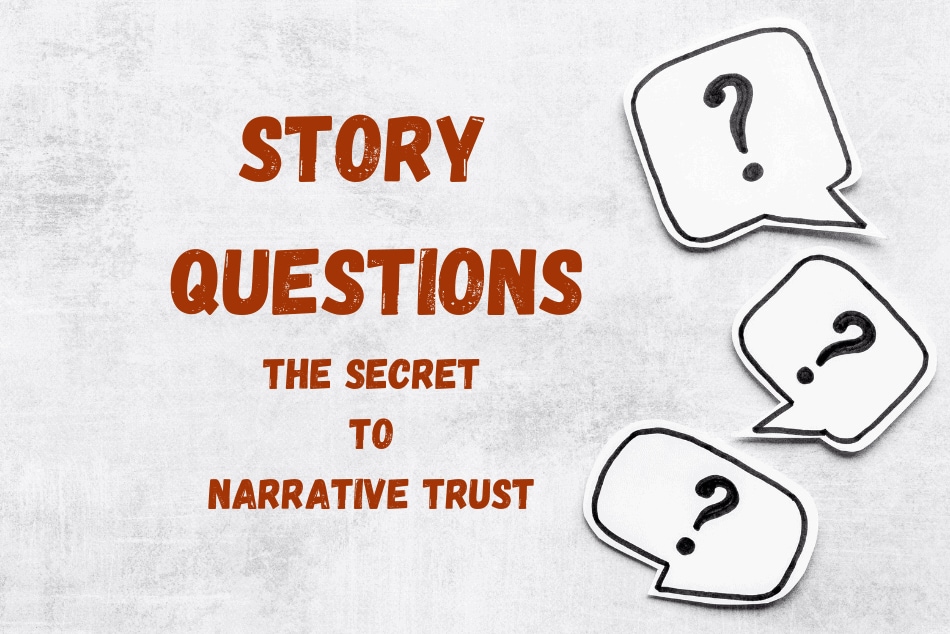One of the most common reasons agents and editors pass on stories—and readers stop reading them—is a lack of narrative thrust. Narrative thrust is the engine that propels your story forward, beat by beat, scene by scene, chapter by chapter, from the very first word to The End. Without it, your story sputters to a stop—and your readers abandon your book.
There’s a secret to maintaining narrative thrust—and that secret is story questions. These are the who, what, where, when, why, and how questions you build into your prose to keep readers reading.
The Three Types of Story Questions
There are three types of story questions:
- The macro story question, which is the question that drives the main action: Will Cinderella marry her prince? The bigger the macro question, the better.
- The meso story question, which is the question that drives a given scene: How will Cinderella get to the ball? The most compelling scenes open with one story question, and end with another.
- The micro story questions, which are the questions that pepper the prose itself: Why did Cinderella’s father marry such a horrible woman? Why are her stepsisters so hateful? Will Cinderella finish her chores in time? Will she ever leave the house? What will she wear? Who’s this fairy godmother? How will she help Cinderella? What will happen at the ball? Will the Prince like her? Is it midnight yet? And on and on…. The trick here is to pose story questions that make the reader think, “What’s going to happen next?” As opposed to, “What is happening now?” Clarity is key.
How to Use Story Questions
Look at the opening of my story The Long Way Home and the story questions posed right from the beginning:
Mercy Carr took the long way home. [Long way home from where?] Eight hundred and fifty-eight miles through the Bald Mountains, along the spectacularly beautiful Blue Ridge Parkway, winding in and out of forest, navigating twisty hairpin turns, speeding in and out of dark tunnel after dark tunnel. [Why is she in a hurry? Where is she going?]
The Appalachians were not her mountains. [Where are her mountains?] The Green Mountains were her mountains. [Where are the Green Mountains?] But she was a mountain girl. [How so?] She would follow the mountains all the way home to Vermont.
It was safer this way. [Why is it safer that way?] Even if it were winter and another snowstorm could blow in any minute. [Why is she driving in such bad weather? Is she on the run?] This way she was less likely to run into any cops looking for stolen goods or crooks looking to retrieve stolen goods. [She’s a criminal? Who is this Mercy Carr? What did she steal?] She glanced over at the front passenger seat, where Martinez’s dog rode shotgun. [Who’s Martinez? Why does she have his dog?]
Technically Elvis was not Martinez’s dog. [Then whose dog is it?] Technically he was not the U.S. Army’s dog. [Elvis was in the Army? What did he do?] Technically the bomb sniffer dog belonged to the defense contractor that sent him off to Afghanistan. [So he’s a hero dog? Did he really sniff out bombs in the war? He’s a defense contractor dog? What does that mean exactly?]
Technically, he was stolen goods. [Why did she steal this hero dog?]
You’ll notice that as I continue to pose story questions, I also answer some of them. This is the rhythm of story questions you’re aiming for—ask some, answer some, ask some more. You don’t want to frustrate readers by never answering any of the questions that arise in their minds as they read. Answer enough to satisfy them and then hook them again with additional story questions.
Note: The Long Way Home is the origin story for my award-winning Mercy Carr mystery series. You can read it for free if you sign up for my newsletter.
Test Your Story Question IQ
Go through your manuscript and identify the story questions that you’ve used throughout your narrative. If you’re short on questions, you’re short on narrative thrust.
If you’re still not sure how to use story questions, turn on your fave TV show/limited series. Write down the story questions that arise in your mind as you watch. Pay special attention to the story questions that end each scene, lead into commercials, and/or end each episode.
Rev Up Your Engine
Master the art of story questions, and you’ll know how to rev up that engine of narrative thrust, and keep it going throughout your story. Because the only real rule in writing is: Keep the reader reading. And story questions help you do just that.
NOTE: This post was originally published at Career Authors.
